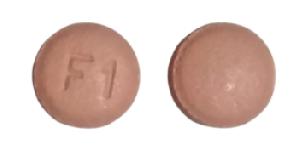Fluphenazine Side Effects
Medically reviewed by Drugs.com. Last updated on Nov 6, 2023.
Applies to fluphenazine: oral elixir, oral solution concentrate, oral tablets, parenteral injection.
Warning
-
Increased Mortality in Geriatric Patients with Dementia-related Psychosis
- Geriatric patients with dementia-related psychosis treated with antipsychotic agents are at an increased risk of death.100 101 102 103 c f g i j k l
- Analyses of 17 placebo-controlled trials in geriatric patients mainly receiving atypical antipsychotic agents revealed an approximate 1.6- to 1.7-fold increase in mortality compared with that in patients receiving placebo.100 c f g i j
- Most fatalities appeared to result from cardiovascular-related events (e.g., heart failure, sudden death) or infections (mostly pneumonia).b c f g i j
- Observational studies suggest that conventional or first-generation antipsychotic agents also may increase mortality in such patients.100 c f g i k
- Antipsychotic agents, including fluphenazine, are not approved for the treatment of dementia-related psychosis.100 101 c f g i j
Side effects include:
Extrapyramidal reactions (e.g., pseudo-parkinsonism, dystonia, dyskinesia, akathisia, oculogyric crises, opisthotonos, hyperreflexia), drowsiness, lethargy, weight gain.
For Healthcare Professionals
Applies to fluphenazine: injectable solution, oral concentrate, oral elixir, oral tablet.
General
The most commonly reported side effects include extrapyramidal symptoms (e.g., pseudoparkinsonism, dystonia, dyskinesia).[Ref]
Hematologic
Rare (0.01% to 0.1%): Blood dyscrasias
Frequency not reported: Transient leukopenia/leukopenia, thrombocytopenia, leukocytosis, agranulocytosis/fatal agranulocytosis, cellular depression, eosinophilia, pancytopenia, aplastic/hemolytic anemia, thrombocytopenic or nonthrombocytopenic purpura[Ref]
Metabolic
Rare (0.01% to 0.1%): Increased serum cholesterol
Frequency not reported: Hyponatremia, loss of appetite, weight changes, blood glucose level alterations and loss of diabetic control[Ref]
Hepatic
Rare (0.01% to 0.1%): Jaundice
Frequency not reported: Cholestatic jaundice, hepatitis, increased cephalin flocculation and transient liver function test abnormalities (in the absence of jaundice)[Ref]
Musculoskeletal
Very rare (less than 0.01%): Systemic lupus erythematosus
Frequency not reported: Muscular rigidity, altered creatine phosphokinase, acute, distressing muscle spasms in the face, neck, eyes, tongue, and back[Ref]
Acute, distressing muscle spasms usually occurred within 24 hours of injection, and required immediate administration of an anticholinergic agent.[Ref]
Immunologic
Very rare (less than 0.01%): Antinuclear antibodies[Ref]
Nervous system
Parkinsonism/parkinsonian-like states tended to occur 2 to 5 days after each injection, with a decreased frequency in subsequent injections. This side effect may be reduced by using smaller, more frequent doses or adding an anti-parkinsonism agent temporarily.[Ref]
Frequency not reported: Opisthotonos, parkinsonism, pseudoparkinsonism/parkinsonian-like states, dyskinesia, tardive dyskinesia, drowsiness, lethargy, headache, dystonia, acute dystonia/acute dystonic reactions, epileptiform attacks, altered consciousness, stupor, coma, neuroleptic malignant syndrome, autonomic instability, hyperreflexia, akinesia, electroencephalographic tracing alterations, alterations in cerebrospinal fluid proteins, cerebral edema, impairment in judgement and mental skills[Ref]
Cardiovascular
Frequency not reported: Mild hypotension/hypotension, hypertension, arrhythmias, ventricular tachycardia/fibrillation, venous thromboembolism, deep vein thrombosis, edema, peripheral edema, labile blood pressure, tachycardia, ECG changes, fatal cardiac arrest, QT and T-wave changes[Ref]
ECG changes (including QT and T-wave changes) were dose-related side effects that usually occurred at moderate to high doses. These changes may preclude serious arrhythmias.[Ref]
Genitourinary
Frequency not reported: Galactorrhea, abnormal lactation, oligomenorrhea, amenorrhea, menstrual irregularities, impotence, priapism, inhibition of ejaculation (men), increased libido (women), impaired sexual function, bladder paralysis, polyuria, urinary hesitance and/or incontinency[Ref]
Dermatologic
Frequency not reported: Abnormal skin pigmentation, skin rashes, diaphoresis/perspiration, itching, erythema multiforme, contact sensitivity, urticaria, seborrhea, photosensitivity, eczema, exfoliative dermatitis, angioneurotic edema[Ref]
Abnormal skin pigmentation occurred in patients receiving high doses for long durations of time.[Ref]
Gastrointestinal
Frequency not reported: Tongue protrusion, dry mouth, constipation, vomiting, nausea, gastric irritation, salivation, fecal impaction, paralytic ileus, difficulty swallowing, aspiration of gastric contents, hypertrophic papillae of the tongue[Ref]
Ocular
Lens opacities occurred in patients receiving high doses for long durations of time.[Ref]
Frequency not reported: Oculogyric crises, blurred vision, lens opacities, glaucoma, mydriasis, corneal opacity, pigmentation of the eyes, pigmentary retinopathy, defective color vision, night blindness, deposition of particulate matter in the lens and cornea[Ref]
Other
Sudden, unexplained/unexpected death occurred in hospitalized patients with psychosis.[Ref]
Frequency not reported: Neonatal drug withdrawal syndrome
Postmarketing reports: Sudden, unexplained/unexpected deaths, body temperature dysregulation, hypothermia, hyperthermia[Ref]
Psychiatric
Frequency not reported: Agitation, restlessness, excitement, insomnia, bizarre dreams, increased aggressiveness, reactivation/aggravation of psychotic processes, catatonic and confusional states[Ref]
Respiratory
Frequency not reported: Nasal congestion, pulmonary embolism, laryngeal dystonia, asthma, throat tightness, difficulty breathing, active fulminating pneumonia or pneumonitis[Ref]
Endocrine
Frequency not reported: Hyperprolactinemia, gynecomastia, false positive pregnancy test, syndrome of inappropriate antidiuretic hormone secretion[Ref]
Hypersensitivity
Frequency not reported: Anaphylactic and hypersensitivity reactions[Ref]
Renal
Frequency not reported: Acute renal failure[Ref]
Local
Frequency not reported: Local tissue reactions[Ref]
More about fluphenazine
- Check interactions
- Compare alternatives
- Pricing & coupons
- Reviews (24)
- Drug images
- Dosage information
- During pregnancy
- Drug class: phenothiazine antipsychotics
- Breastfeeding
- En español
Patient resources
- Fluphenazine drug information
- Fluphenazine Tablets
- Fluphenazine Decanoate Injection
- Fluphenazine Elixir
- Fluphenazine Injection
- Fluphenazine Oral Concentrate
Professional resources
- FluPHENAZine monograph
- Fluphenazine Elixir (FDA)
- Fluphenazine Hydrochloride Injection (FDA)
- Fluphenazine Injection (FDA)
- Fluphenazine Oral Solution (FDA)
- Fluphenazine Tablets (FDA)
Other brands
Related treatment guides
References
1. Product Information. Prolixin (fluphenazine). Bristol-Myers Squibb. 2001;PROD.
2. Cerner Multum, Inc. UK Summary of Product Characteristics.
3. Cerner Multum, Inc. Australian Product Information.
Further information
Always consult your healthcare provider to ensure the information displayed on this page applies to your personal circumstances.
Some side effects may not be reported. You may report them to the FDA.

